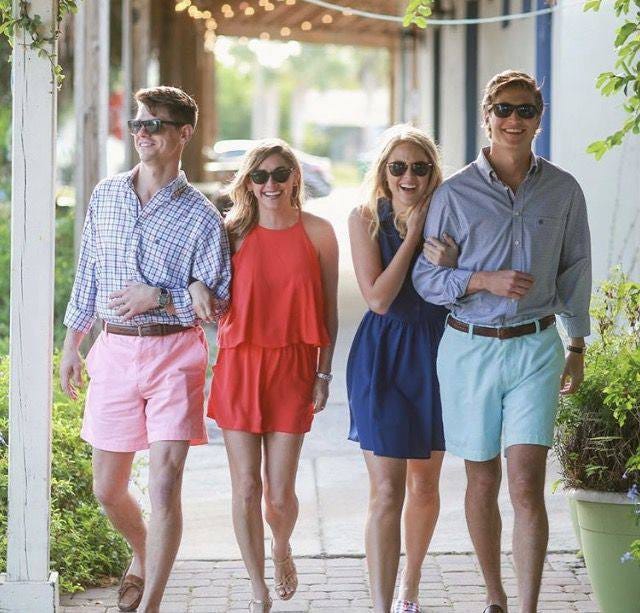For the Left, aesthetics is a political project. For the Right, politics is an aesthetic project.
We at the Old Glory Club have written before on the Metaphysics of Dress, and our organization stands in the tradition of Anglo-American club culture in demanding of our members a certain level of effort and seriousness in how they present themselves.
In our age, there is not only a great deal of sloppiness in regard to personal appearance and dress, but a great deal of leveling. Whether you are in Alaska or Florida, California or Maine, the same cheap clothes from Southeast Asia reign everywhere. Walking into a Walmart anywhere in the country, you will see a truly brutal reversion to the mean.
I was not born in the tropics, but I have grown to appreciate their charm, as well as the unique challenges they impose upon all men, but particularly on White men. Lee Kuan Yew said of Air Conditioning: “It changed the nature of civilization by making development possible in the tropics. Without air conditioning, you can work only in the cool early-morning hours or at dusk.”
Unfortunately, however, Air Conditioning had the effect of making life in the tropics more or less like everywhere else. I of course appreciate it as the civilizational advancement it is, and yet I find myself irked by the fact that the teenagers wear the same polyester sweatpants and hoodies here as everywhere else.
I’m sure you’ve heard the expression “Men don’t wear shorts.” Tom Ford issued the fatwa against them1 except when at the beach or playing sports more recently, but the hostility dates back to Elizabeth II’s official designer.2 MEL magazine had a pretty amusing article3 where they interviewed a number of men about their habits regarding shorts, and the tenor essentially comes down to “I don’t feel comfortable in them.”
But in the tropics it is different, and it always has been. When the British Empire spanned the globe, it was quickly compelled into the innovation that would create madras and seersucker, two weaves of cotton uniquely suited for tropical climates. In Bermuda, however, this wasn’t enough. To help them deal with the brutal heat, a tea shop owner named Nathaniel Coxon hemmed his employees’ uniforms down to shorts.4 The British army stationed in Bermuda at the time followed suit. From there, they took off. Classic ’50s menswear saw them all over the country, whether for a cookout or a campfire. They are distinguished in that they end about an inch before the knee. In both Bermuda and elsewhere, these shorts were paired with ties and sport jackets, or sometimes just a plain OCBD.
Bermuda Shorts are nothing like the shorts that occupy the public conception of “men who wear shorts.” They are stylish, totally lacking the baggy pockets and capri inseam of the cargo shorts dads routinely embarrass their children by wearing. The tropics demanded not only new weaves of fabrics but new modes of dress. The man who wears Bermuda Shorts is proud of his body, and has reason to be. As with the Polo, Bermuda Shorts are not flattering to fat “people,” but they are supremely flattering to those who are fit.
The Bermuda Shorts represent the very best of Colonial excellence, a daring and flare that suits the men of quality who wore them, men who helped conquer the world in the 20th century. Bermuda Shorts are for the man who is unflappable, supremely confident, who breaks the rules of lesser men with a smirk. The tropics require consciousness about your position as a paleface. In Joseph Conrad’s masterpiece Heart of Darkness, the protagonist is told by the company doctor: “In the tropics one must before everything keep calm.” Bermuda Shorts are one of the White man’s means of doing this, and doing this in style. Throw on a pair of Sperrys to go with them, and you have a superior style to nearly anyone around you, while remaining cooler than any of them.
The tropics are no longer as oppressive as they once were, but they are still a distinct place on the American continent. You can absolutely get away with wearing the same clothes you would anywhere else in the country here. But for those of us who call this place home, we should not aspire to average, but to set the tone, style, and demonstrate the excellence we hail from.
So to hell with the naysayers — shorts are for men.
Recommended Reading
“The Metaphysics of Dress” by Not Me Not You
“Battlefield Aesthetica” by T.J. Martinell
“Rush Week and Red Hats” by Doug the Intern
Tracy Moore, “Why Some Men Refuse to Wear Shorts,” MEL.
Guillermo Arenas, “‘A man should never wear shorts’ — but has the moment arrived to show some leg?” El País, May 12, 2024.
Ibid.
“Knee Deep in History,” TABS Bermuda.






Excellent article. However, no study of shorts is complete without mentioning the Rhodesian Army.
I once read somewhere that until the late 1960s the British had a consulate in my hometown of St. Louis, and that it was considered a tropical posting. As such, the story goes that their personnel were issued the same warm weather gear as issued to those posted to the likes of Bermuda or Hong Kong. I don't know it the story is true, or perhaps apocryphal, given the sweltering summer temperatures here, but the thought of Limeys sauntering through our streets in khaki shorts and pith helmets always gives me a chuckle.